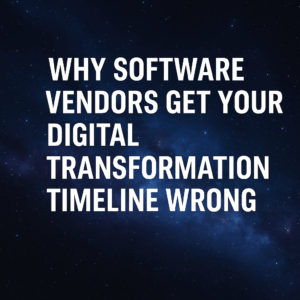There are a lot of pitfalls to consider when embarking on a business software deployment. While the need for and benefits of new technology may be obvious for your organization, the path to achieving that future state is not as clear.
Perhaps the most important thing to remember about business software deployments is that they really aren’t about the software. They are most about strategy, business processes, and people.
But what exactly does this mean? Here are five keys to help you become more successful in your business software deployment.

Table of Contents
Toggle1. Do not begin with technology in mind first
The first thing is to avoid a common pitfall: leading with technology. In other words, you don’t want to make the frequent mistake of becoming too enthralled with technology without first considering the needs of your business.
It is easy to become enamored by artificial intelligence, the internet of things, cloud technology, and other technological breakthroughs. However, these innovations don’t matter if they do not support your business and are not aligned with your strategic objectives. Best in class implementations begin with business strategy, business process improvements, and organizational structure – before determining how to best overlay technology on those future needs.
2. Define your business needs and requirements
But how exactly do we begin with something other than technology? One of the first steps is to define your business needs and requirements. This includes a clear definition of things such as:
- How your overarching business strategy translates to a digital transformation strategy that best fits your business.
- Your future state business processes and requirements.
- The way your organization will be designed in the future, including job roles and responsibilities within that new structure.
- Your expected business case and return on investment for any potential technology investments.
Some of these things will be iteratively defined over time, but it is important to at least have a first, high-level draft of these and other business needs prior to evaluating and selecting potential business software solutions.
3. Consider all of your options
When you speak with software vendors, you will hear promises of silver bullets and other one-size-fits-all answers. But don’t take the bait.
What may make sense for one organization may be a terrible idea for your business? What industry analysts tout as the next big thing or “must-have” for enterprise technologies may not make any sense for your organization’s strategy or culture. Be sure to filter any biased sales messages and take them with a grain of salt.
When defining your business software deployment options, you may find that any one or more of the following may make sense for your organization:
- Enterprise resource planning (ERP) software
- Customer relationship management (CRM) systems
- Human capital management (HCM) software
- Supply chain management solutions
- Business intelligence, finance, and accounting technology
- Cybersecurity
- Best of breed enterprise systems
- Single, integrated ERP systems
There is no one “correct” answer for your organization. The key is to hone in on the specific types of software that will best enable your future state strategy and business needs.

4. Focus on architecture, data, and integration
The biggest technological challenges of business software deployments are typically not caused directly by the software. Instead, how systems speak to one another via integration, how data is cleansed and migrated, and the overall solution architecture are more likely to create problems.
It is important to have a clear solution architecture plan in place as part of your implementation planning process. These activities will connect the dots between the core systems you may be implementing with the other pieces of your integration puzzle. They will also help ensure that you have a realistic view of the technology risks, time commitments, and resource requirements to enable a successful overall deployment.
5. Make organizational change management your #1 priority
The #1 key to your software deployment success has nothing to do with technology – it has to do with people. How well your employees and stakeholders understand and embrace change (or not) will determine your level of deployment success.
Organizational change management is more than just communicating changes and training people on the new software. It goes well beyond that. It begins with designing the future state of the organization, identifying how exactly different departments and workgroups will be impacted, and ultimately enabling those changes well before end-user training, just before go-live. These are all key to an effective organizational change management strategy.
Next steps in your software deployment
Business software deployments are never easy, but they are attainable with the appropriate focus and priorities. The key is to focus more on the “business” and less on the “software” components of your transformation.
Please feel free to contact me if you would like to discuss your business software initiative. Whether you are considering ERP, CRM, HCM, supply chain, financials, or other enterprise technologies, I am happy to be a sounding board as you continue your transformation journey!





